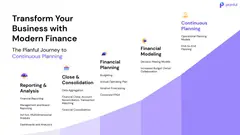ARTICLEMaximizing the ROI of Planning Technology

Organizations invest in technology to improve efficiency, productivity, speed, competitiveness, and other crucial areas that outweigh the cost of the investment. Many companies realize a minimal positive return when they first implement their new technology. However, continued improvement can be elusive and, as your business changes, many companies start to see a decrease in their ROI as they fail to adapt. Here’s how to turn that around.
Who is this guide for?
Finance professionalslooking to justify an investment in planning technology.
Finance teamsseeking to overcome manual, friction-filled planning processes.
CFOs and finance leaderswanting to add more strategic value to all corners of the business.
What you’ll learn
Examples and success storiesfor maximizing the value of planning technology investments for finance and accounting teams.
Ways to maximizethe adoption, usage, and benefits of planning technology throughout Finance, Accounting, and the rest of the business.
How to align your goalswith an investment in the right financial planning technology.
Investing in Better Financial Planning
Every organization conducts a periodic financial planning process to set goals and ensure decisions across the business align with the overall strategy. For most organizations, however, planning is a decidedly slow, manual, and friction-filled process that takes too much time from too many stakeholders. And even with that effort, it produces rigid insights that fail to adapt to today’s fast-changing world.
Especially with the uncertainty and pressures we’re facing today, more and more finance and accounting teams have turned to technology to help alleviate these common issues. The results can be impressive, but only if you take advantage of the full power and capabilities of your planning technology.
Specialized Bicycle Components modernized its global workforce planning and eliminated 6 weeks of manual effort from every planning cycle.
Read Case StudyIf you don’t take full advantage of your investment in planning technology, you’re wasting money, which leads to a poor return on investment (ROI). But, poor technology decisions can create issues beyond just the investment itself, including:
- Complacency with the technology and resistance to adopting ongoing enhancements and broader capabilities.
- Duplicative technology which causes redundant work, overlapping investments, incomplete insights, and the additional cost and complexity of more data movements.
- Employee churn from unhappy teams stuck with old, manual, and mundane tasks or who are forced to deploy complex, time-consuming workarounds.
- Poor or misguided plans, insights, forecasts, and models which result in decreased planning accuracy and bad decisions.
- Misallocation of other investments based on inaccurate forecasts, plans, and models.
Conversely, and more optimally, aligning your technology investment with your goals during the acquisition, and continuing to adjust your solution as your objectives shift will help you to maximize your investment in the technology. So before you make additional investment decisions for planning technology, consider the following:

Decide where to focus your efforts.

Collaborate with your current vendors.

Leverage investments you’ve already made.

Maximize total business impact.
Planning for Maximum ROI
According to the EY Digital Investment Index, companies identifying as “digital leaders” achieve a consistently higher return on digital investments, more robust revenue growth, and consider themselves to be outpacing their industry in digital transformation. What separates digital leaders from average companies are:
- Clearly defined digital goals,
- Choosing technology that aligns with those goals, and
- Focusing on initiatives with quick returns.
While being a digital leader might not be your primary objective, every organization should be on the path towards finance and accounting transformation. Deloitte’s Global Technology Leadership study shows that even “baseline” organizations focus on business innovation by making “offensive technology investments.” So if you merely make incremental progress, you’re still falling behind your competitors.
Forrester interviewed four Planful customers and found these organizations experienced benefits of $1.2 million over three years versus costs of $250,211, resulting in a net present value (NPV) of $984,577 and an ROI of 393%.
Download the Forrester Total Economic Impact report here.While many organizations have purchased financial planning technology, very few actually realize the full scope of what their technology can do for them. Here are four steps to ensure your organization makes the right decisions to maximize planning technology ROI.
1. Decide where to focus your efforts.
Understanding your end-to-end financial planning process and where the risks, bottlenecks, and low value-add activities lie is critical to improving productivity and efficiency. This understanding goes beyond just financial planning to include non-financial planning, reporting, modeling, forecasting, and more. Asking yourself “Can this be automated?” or “Where does this data go next?” will help you understand where some of these blockers could be. Once you’ve mapped out these processes, start looking for process gaps or slowdowns most in need of improvement.
Golden State Foods cut 50% off the time required to develop quarterly business reviews and cut nearly 3 days of monthly reporting and forecasting efforts.
Read the blog2. Determine goals and measure progress.
Set short and long-term goals for improvements and use concrete metrics to measure progress. For planning or consolidations processes, a decrease in cycle times is a good metric to track. For FP&A or operational planning, an increase in accuracy, decrease in meetings, or decrease in time spent planning are all great metrics to improve. The measurable elements you intend to improve—cost savings, cycle times, responsiveness, nights and weekends worked—will feed into broader growth and performance goals.
3. Maximize the impact in every corner of the business.
As you see success in finance and accounting, it’s time to share the value with your broader organization. The manual process that you finally automated, how much time does that save you? Are you more comfortable with your financial reports? It’s painfully clear that spreadsheet- and email-driven planning processes cost your organization real-time and money in every department. Automation is a great start, but it’s equally important to enable the business to participate easily in planning processes, collaborate with Finance, and have self-service access to the financial intelligence they need to make better, faster decisions. Ask yourself how you could work better with your business partner.
There are benefits of digital acceleration for every corner of the business. Quickly enabling the business with a cloud-based planning technology helps dramatically improve the overall ROI of the project.
The above points, however, are table stakes for realizing a maximum ROI on your planning technology investment. Other critical components include having strong leaders and project champions, bringing the most forward-thinking teammates onto the platform first, shouting the benefits and wins along the way, and being confident to push your planning process and your organization forward.
Where Are You Today?
You’re likely already feeling the pain of changes to your business over time, but have you had the opportunity to change how you plan? As your plans change, you need to stay ahead of the business and that means making sure your technology is being leveraged across data collection, planning automation, seamless collaboration, and expedited reporting to meet the needs of your teams and partners. Knowing where you are and being honest about the path ahead can drastically improve your eventual ROI.
“Because we’re able to be more proactive and forecast over the course of a year, we saved an additional half-million to $1 million in expenses that otherwise would have been water under the bridge in the old, Excel-driven world.”
Read the Boston Red Sox case study.Most organizations begin improvements by focusing on financial close and reporting. That’s a great start, but Finance transformation continues building on that foundation to bring all corners of the business into a collaborative planning process or Continuous Planning effort. Here is a simple framework for gauging maturity and determining where to advance your efforts:

Your Next Step
Digital investments into business-wide planning are helping countless organizations accelerate processes, alleviate the burden of manual effort, and give accounting and finance teams more time to collaborate with the business. To maximize your ROI from planning technology, look at the low-hanging fruit of manual processes while setting a goal of what great looks like. As more processes become automated, you’ll free up more time to think about where your planning technology can provide the most value in the shortest time.
Curious about your next step? Reach out to your customer success or account manager to see what continuous improvements could look like for you.
Get Started with Planful
- How much time will you save?
- How will your finance team evolve?
- Where will technology support you?